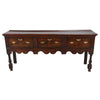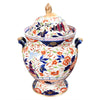News
Welsh (and English) Dressers
When I was growing up, a dresser was the piece of furniture in your bedroom that held your clothes, basically a bank of drawers raised on feet or a low plinth. When I began working for Jayne, fresh out of college, I had to re-learn some of my vocabulary. What I once called a “dresser,” I now know as a chest of drawers. In the world of antique British furniture, a “dresser” is the ancestor to and country cousin of the formal sideboard. It is called a dresser because the serving surface was used to dress the food. Since they were created for more modest homes, dressers are not as deep as sideboards which had to accommodate the more elaborate serving apparatus of a formal dinner service. These proportions—long, but shallow and of serving height—are what make dressers so useful and versatile in a modern interior. Many of our clients still use them as sideboards in dining rooms, but they also work well in long hallways, behind sofas, as focal pieces in living spaces below art or with a rack filled with colorful porcelain or whatever collection you might wish to display.
Dressers are one of our favorite forms. Within their basic framework can be found a world of variety. Commonly known as Welsh Dressers, many of them were indeed created in Wales, and possibly originated there. However, they were created throughout England as well and certain forms are associated with certain counties. While many of them (not all) began life with racks to store plates and hang cups, the racks and bases were often separated over the course of their lifetime. See below for several examples from our stock both past and present.
Dressers can be solid to the ground or "enclosed" to maximize storage:
Lots of them stand on legs of differing types such as cabriole legs:
Or straight, square stock legs:
Or sometimes silhouette legs:

Turned legs are some of the most common type (although it is unusual to see the back legs also turned as in this example):
Sometimes those turned legs are connected by a shelf, known as a potboard:
The more refined ones might have adornments such as a shaped apron and cross-banding:
Or maybe a bit of inlay

Some of them have been dressed up with interesting architectural features:
Some enclosed dressers have an opening in the center charmingly referred to as a dogpen:

While the overwhelming majority of dressers are built of oak, it is exciting to find others in more unusual timber. We currently have this gem in fruitwood (possibly pear?):
This primitive dresser from our sold archive was particularly unusual for it’s yew timber:

And this one in highly figured ash will always remain one of our favorites:

We have a continuously rotating stock of dressers in inventory or on the way. They seem to be as popular with our clients as they are with us, so if you see one you like, be sure to contact us before it's gone.
A Coffee Table for a Casual Setting

Thank you to Bunny Williams and House Beautiful for the mention in February's issue. Bunny's work continues to inspire us to see new ways to incorporate antiques and other interesting objects into homes that are comfortable, interesting, and fun. One of our 19th Century Indian low tables makes the perfect coffee table in an East Hampton barn which Bunny transforms into "a cozy English country house" as described and pictured in Work a Room. We've sold a number of these tables over the years and currently have three in stock. They solve that hard-to-crack problem of what to use for a coffee table in a casual setting. We've placed these tables in beach homes, mountain getaways, and English country houses. Made of very dense acacia wood and raised on very thick turned legs, these tables are strong enough to dance on (if you're so inclined). The beautiful timber and use of iron details, including massive nails, lends a rustic charm to these very useful tables.

One of three acacia wood low tables currently in stock. Rajasthan, circa 1880:





































